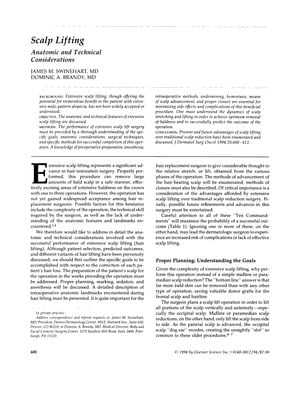TLDR Scalp lifting surgery can safely and effectively reduce baldness if done with careful planning and proper technique.
In 1994, Dr. James M. Swinehart and Dr. Dominic A. Brandy presented a detailed discussion on scalp lifting, a surgical technique for treating male-pattern alopecia by removing large areas of bald scalp. They provided anatomic and technical considerations, including the "Ten Commandments" for successful surgery, which emphasized proper planning, patient preparation, and understanding of anatomy. The procedure, which was not widely accepted at the time, was described as capable of safely and effectively removing significant amounts of bald scalp, potentially in one to three operations. The authors noted that scalp lifting had advantages over traditional scalp reduction, such as removing more bald skin and saving donor grafts. They recommended preoperative scalp massage and expansion to increase laxity and prior occipital artery ligation to reduce necrosis risk. The paper reported minimal complications in over 200 recent cases and suggested future improvements to the technique. The authors concluded that careful attention to surgical details and training could maximize successful outcomes in scalp lifting surgery.
 3 citations
,
September 1992 in “The Journal of Dermatologic Surgery and Oncology”
3 citations
,
September 1992 in “The Journal of Dermatologic Surgery and Oncology” The conclusion is that modifying scalp lifting surgery by cutting one occipital artery and making other changes reduces complications and improves outcomes for patients with severe hair loss.
 14 citations
,
May 1988 in “The Journal of Dermatologic Surgery and Oncology”
14 citations
,
May 1988 in “The Journal of Dermatologic Surgery and Oncology” The conclusion is that bilateral lateral scalp reduction has a high risk of severe complications, leading doctors to stop using it.
 40 citations
,
December 1980 in “The Journal of Dermatologic Surgery and Oncology”
40 citations
,
December 1980 in “The Journal of Dermatologic Surgery and Oncology” An improved scalp reduction technique reduces the need for hair grafts and has minimal complications.
 10 citations
,
January 2011 in “Journal of Cutaneous and Aesthetic Surgery”
10 citations
,
January 2011 in “Journal of Cutaneous and Aesthetic Surgery” Surgical methods for hair loss are less common than hair transplants but still useful, especially for scarring hair loss.
 October 1987 in “Clinics in Dermatology”
October 1987 in “Clinics in Dermatology” Scalp reduction can improve hair distribution in certain baldness cases but requires careful patient selection and understanding of facial structure.
 3 citations
,
September 1992 in “The Journal of Dermatologic Surgery and Oncology”
3 citations
,
September 1992 in “The Journal of Dermatologic Surgery and Oncology” The conclusion is that modifying scalp lifting surgery by cutting one occipital artery and making other changes reduces complications and improves outcomes for patients with severe hair loss.
 24 citations
,
August 2013 in “Facial Plastic Surgery Clinics of North America”
24 citations
,
August 2013 in “Facial Plastic Surgery Clinics of North America” Hair restoration surgery can have complications; success depends on patient education, careful planning, and proper execution.
 12 citations
,
July 2008 in “Facial Plastic Surgery Clinics of North America”
12 citations
,
July 2008 in “Facial Plastic Surgery Clinics of North America” The document concludes that careful planning and consideration of male brow anatomy are essential for successful facial rejuvenation with cosmetic surgery.







